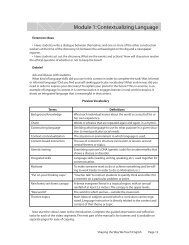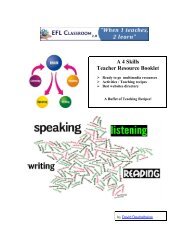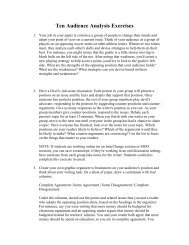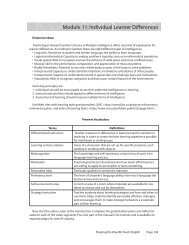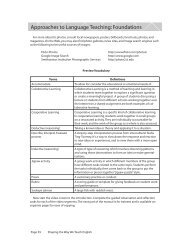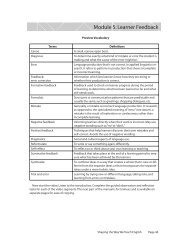Module 7: Learning Strategies - EFL Classroom 2.0
Module 7: Learning Strategies - EFL Classroom 2.0
Module 7: Learning Strategies - EFL Classroom 2.0
Create successful ePaper yourself
Turn your PDF publications into a flip-book with our unique Google optimized e-Paper software.
Approaches to Language Teaching: Extension<br />
functional and contextualized practice with the strategies, self-evaluation and monitoring of language<br />
performance, and suggestions for or demonstrations of the transferability of the strategies to<br />
new tasks. This sequence is not prescriptive of strategies that the learners are supposed to use, but<br />
rather descriptive of the various strategies that they could use for a broad range of learning tasks.<br />
The third framework, developed by Chamot and O’Malley (1994), is especially useful after students<br />
have already had practice in applying a broad range of strategies in a variety of contexts. Their<br />
approach to helping students complete language learning tasks can be described as a four-stage<br />
problem-solving process.<br />
(1) Planning. Students plan ways to approach a learning task.<br />
(2) Monitoring. Students self-monitor their performance by paying attention to their strategy use<br />
and checking comprehension.<br />
(3) Problem Solving. Students find solutions to problems they encounter.<br />
(4) Evaluation. Students learn to evaluate the effectiveness of a given strategy after it has been applied<br />
to a learning task.<br />
Options for Providing Strategy Training<br />
A variety of instructional models for foreign language strategy training have already been developed<br />
and implemented in a variety of educational settings. Seven of these are described below.<br />
General Study Skills Courses. These courses are sometimes intended for students with academic<br />
difficulties but can also target successful students who want to improve their study habits. Many<br />
general academic skills can be transferred to the process of learning a foreign language, such as using<br />
flash cards, overcoming anxiety, and learning good note-taking skills. These courses sometimes<br />
include language learning as a specific topic to highlight how learning a foreign language may differ<br />
from learning other academic subjects. Foreign language students can be encouraged to participate<br />
in order to develop general learning strategies.<br />
Awareness Training. Lectures and Discussion. Also known as consciousness-raising or familiarization<br />
training, this consists most often of isolated lectures and discussions and is usually separate<br />
from regular classroom instruction. This approach provides students with a general introduction to<br />
strategy applications. Oxford (1990) describes awareness training as “a program in which participants<br />
become aware of and familiar with the general idea of language learning strategies and the way such<br />
strategies can help them accomplish various language tasks” (p. 202).<br />
Strategy Workshops. Short workshops are another, usually more intensive, approach to increasing<br />
learner awareness of strategies through various consciousness-raising and strategy-assessment activities.<br />
They may help to improve specific language skills or present ideas for learning certain aspects<br />
of a particular foreign language. These workshops may be offered as non-credit courses or required<br />
as part of a language or academic skills course. They often combine lectures, hands-on practice with<br />
specific strategies, and discussions about the effectiveness of strategy use.<br />
Peer Tutoring. “Tandem” or peer tutoring programs began in the 1970s in Europe and are flourishing<br />
in many universities across the United States. Holec (1988) describes this system as “a direct language<br />
exchange” program that pairs students of different native language backgrounds for mutual<br />
tutoring sessions (e.g., an English-speaking student studying Italian and a native-Italian-speaking<br />
student learning English). Requirements of the tutoring sessions are that students have regular meetings,<br />
alternate roles of learner and teacher, practice the two languages separately, and devote equal<br />
Page 112<br />
Shaping the Way We Teach English



